From The CRPG Addict
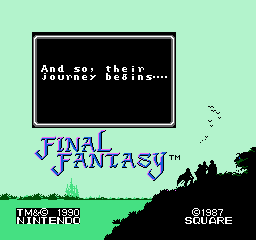 |
| This title screen doesn’t occur until a couple of hours into the game. |
Final Fantasy
Japan
Square (developer); Nintendo (publisher)
Released in 1987 for NES in Japan, 1989 for MSX, 1990 for NES in North America
Remade numerous times for various platforms, including mobile, between 1994 and 2016
Date Started: 11 June 2020
I decided it was time. There are a few things that I want to do in the future that all require me to have had a look at the first game in this apparently never-ending series. I had an original plan to cover the game in a single entry, as I’ve typically done with console games, but it’s clear to me now that to do it justice, the entry would have to be the size of small novel. Keep in mind that I’m fitting this in between my regularly scheduled titles, so I’ll cover as much as I can in this initial entry, you can all tell me what I’m doing wrong, and I can pick it up again at a future date.
We’ve seen eight Japanese RPGs prior to 1987 on this blog, representing a fairly wide range of subgenres, including a text/RPG hybrid (
The Dragon and Princess, 1982), a
Wizardry-inspired first-person dungeon crawler (
The Black Onyx, 1984), and a number of console-style action games with limited RPG elements (
Dragon Slayer, 1984;
Deadly Towers, 1986). While these games don’t share much, they do have characteristics common for a genre in its toddler years–lots of unevenness, stumbling, and experimentation along ultimately unproductive paths.
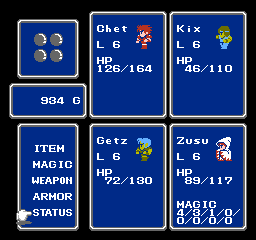 |
| The game’s status screen. Those four orbs in the upper-left are going to become important somehow. |
To me, 1987 feels like the first year that Japanese RPGs learned how to walk. (We do have to keep in mind that there are more than 40 untranslated games between 1982 and 1986 that might change my mind.) The Ancient Land of Ys, Sorcerian, and now Final Fantasy feel like whole products in the way that their predecessors do not. That doesn’t mean that they’re original; Final Fantasy, as we’ll see, is mostly a composite of several American RPGs, particularly Wizardry, Ultima, and Phantasie. But when borrowing elements from a previous title, there’s a difference between doing it blindly and doing it craftily. In playing most clones, you get the sense that the developer of the clone didn’t know any better; that he included an element because he couldn’t think of an alternative; that he didn’t have enough experience with the scope of previous RPGs to truly understand when something works and why. Final Fantasy is something of the opposite. It strikes me as a product of someone who has really analyzed the best American RPGs and has deliberately created a composite of their strongest characteristics.
In fact, I’m willing to venture that at the time, it might not have been possible to create a better console RPG experience. It exemplifies the simplicity that we have come to expect from a console of the era. It doesn’t bog itself down in character creation or in a long backstory, and it requires minimal preparation in terms of reading a manual. It is the very essence of plug-and-play. As I started playing, I initially saw its approach as an object of criticism, but as the hours wore on, I began to understand. The game has a relatively detailed backstory; it just chooses to feed it to the player in small bites. It comes with an 84-page manual, but the first two pages cover everything you need to know to get started (the rest quite literally walk you through the entire first half of the game). Its one-line dialogues seem less like a limitation of the platform and more like an effort not to exhaust the player with too much text. I don’t always like the result, but I admire its success in what it wanted to achieve.
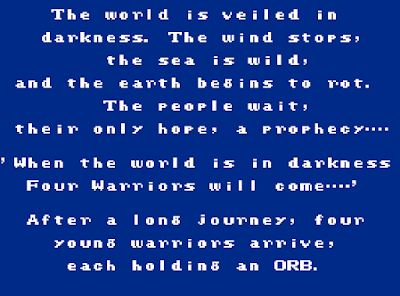 |
| The only backstory you get. |
So little has been provided on the backstory so far that I’m not even sure how to summarize it. A single-screen opening text crawl says that the world is in trouble (for some reason), but a prophecy says that four warriors will set things right. Enter your four warriors, “each holding an ORB.” That’s enough to start you off, but with every town and castle you visit, you learn just a little bit more. Not in the way–I hasten to add–that you learn more about the main plot of, say, The Legacy or Ultima VII. Those games have mysteries that you slowly unravel, but at least it’s perfectly clear from the beginning who you are and what your basic mission is. In Final Fantasy, on the other hand, you get the sense that your own characters know more than you do. After all, they each have an ORB. Why? Where did they get them? Why do people keep calling them “Warriors of Light”?
Character creation allows you to select four characters from six classes: fighter, thief, black belt, red mage, white mage, and black mage. Aside from the “black belt,” these seem mostly inspired by Wizardry, with the white mage taking the role of the priest (mostly defensive and healing magic), the black mage taking the role of the mage (mostly offensive spells), and the red mage taking the role of a bishop (able to cast both). The inclusion of a “black belt” class made me chuckle with remembrance of a time in the 1980s when “black belts” were considered the ne plus ultra of martial artists, and you had several games of that title and movies with black belt protagonists. And then dweeby kids we went to high school with started getting black belts, ruining the entire illusion, and we started worshiping more nebulous figures like ninjas whose designations couldn’t be bestowed by the local used car dealer running a “dojo” on the side.
 |
| Party creation is just names and classes. |
Each character is assigned starting attributes in strength, agility, intelligence, vitality, and luck, this list coming from Wizardry but lacking “wisdom.” From these are calculated a variety of derived statistics: damage done, hit percentage, damage absorbed, and evade percentage.
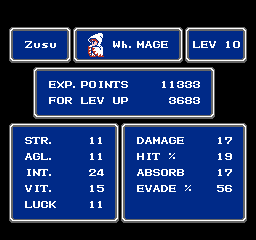 |
| My white mage’s statistics towards the end of this session. |
Once you’ve selected a party, you’re locked in for the game. I selected poorly. I wasn’t paying attention to what the manual said about the different mage classes, and I went with a fighter, a thief, a black belt, and a white mage. A couple hours later, I realized that I really wanted two mages, or at least a red mage instead of a white. The thief doesn’t seem terribly useful–there really isn’t any thieving to be done in the game–and if I could do it over I would have replaced him with a black mage. My selections mean that I miss out on most of the offensive magic in the game. However, each class later gets a “prestige class” upgrade that introduces some more magic options.
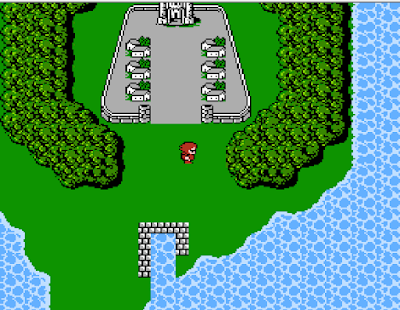 |
| The opening scene. |
Gameplay begins outside a castle with an attached town (it looks like six attached towns, in fact, but the town icons all lead to the same locations). Towns have shops that sell weapons, armor, spells, resurrection, and potions and magic items, the selection getting more advanced as the game progresses. Inns are one of the few places where you can legally save the game (like Zelda, the cartridge came with an internal battery), the others being a variety of temporary magical structures (tents, cabins, and houses) that you can purchase from the magic shop. (Inns restore all hit points while these magic items restore only some.) Either way, save points are limited, and you have to pay to save.
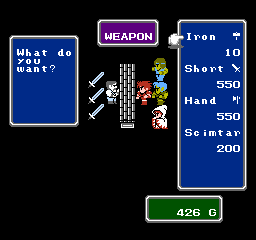 |
| Buying an initial selection of weapons. |
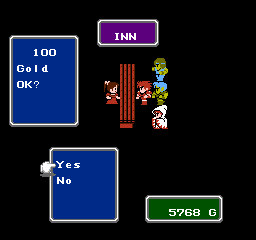 |
| Checking in at the inn. |
Towns also have about half a dozen wandering NPCs, each of whom deliver a sentence or two when you approach them. From the ones in this town, I learn that someone named Lukahn foretold our arrival, and that he has gone to “join his colleagues at Crescent Lake”; the princess has been kidnapped; and the city of Pravoka lies to the east.
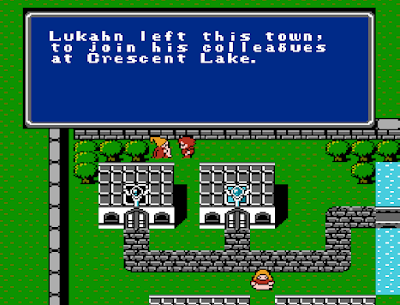 |
| I get a hint from an NPC north of two magic shops. |
At the nearby castle, we learn that Princess Sara has been kidnapped by someone named “Garland,” a former knight until something happened. (If the name seems familiar, it’s also the name of the duke in Zeliard.) He took the princess to a temple to the northeast. For a while, I’m dumb enough to think that this will be the main plot of the game.
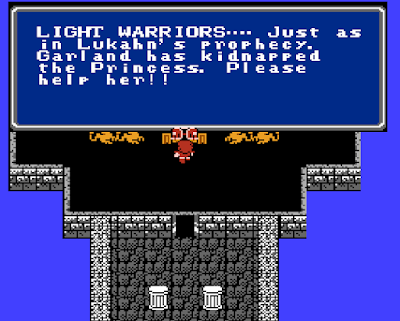 |
| The king asks for my help. I suppose we’ll find out who “Lukahn” is later. |
So far, we’ve encountered a character system similar to Wizardry (classes, attributes, prestige classes, leveling) and a top-down exploration system with towns and NPC dialogue similar to Ultima, but outside we run into combat that couldn’t come from anywhere but Phantasie. Enemies face the party on the combat screen (left-to-right here, instead of top-down). You specify an action for each character–attack, cast a spell, use an item, drink a potion, or flee–and the game threads your actions with the attackers’ based on an underlying initiative score. As each character acts, his icon leaps forward and has an accompanying animation. This is cute at the beginning but (like Phantasie) soon just adds unnecessary time to the encounter. So does the silly dance that the kids do when they’ve won a battle.
 |
| Battle options against a party full of pirates. |
Unlike Phantasie, there isn’t much consideration of enemy rank–any character can attack any enemy. There is a consideration of character rank. The character appearing first gets about 50% of the attacks, the next 25%, then 15%, then 10%. It’s thus important to keep the strongest, most well-armored character at the top. This is particularly annoying because certain enemy effects, like stunning and poison, plus fleeing battle, seems to cause the party to spontaneously re-arrange, and you spend a lot of wasted time untangling them.
The magic system is a hybrid. Final Fantasy uses spells with names and effects similar to Phantasie, with numbers indicating relative power, though all shortened to four characters for space reasons. So instead of “Healing 2” and “Fireflash 3,” we get HEL2 and FIR3. There are four spells per level and spellcasters can only learn three of them, which must create real agony for the red mage, who is mixing white and black magic. Anyway, instead of Phantasie‘s magic points system, Final Fantasy uses the “slots” system of Wizardry, in which each character gets a certain number of spell allocations per level, all of them restored when you rest.
I find the combat system fun and relatively tactical when exploring dungeons (where you can’t save or rest) and facing boss-level enemies. You have to carefully ration your spell slots, strategically use fleeing to preserve your resources, cast the right spells for the foes you’re facing, and find the right balance between concentrating your attacks and spreading them out, so that you kill the most powerful foes as quickly as possible, but don’t waste extra attacks on creatures killed by an earlier character.
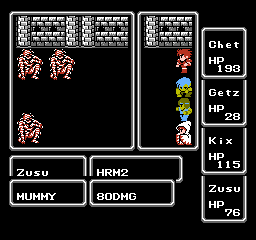 |
| The white mage doesn’t get many damage spells, but she does get one that only works against undead. |
In general, however, combat becomes exhausting quickly. Both outdoors and in dungeons, you get yanked into combat (it’s always a surprise; you don’t see enemies on the screen) every 5 to 10 seconds of travel time. As long as you keep an eye on health levels, most of the outdoor combats are of negligible danger, so all they do is sap time. NESTopia comes with an “alternate speed” mode that you can activate by holding down the TAB key, but it only goes to a maximum of 240%, not the “warp” of other emulators. So I spend a lot of time just holding TAB and mashing my way through combat.
The game is pretty relentless in its generation of “random” encounters, too. If it decides that in 8 seconds, you’re going to face 3 ogres, and they’re going to get a surprise attack, there’s no fiddling that you can do to save yourself, not even using emulator save states. You can’t pause and wait until they pass like you can in Dragon Warrior because their appearance is based on movement rather than time. Duck into a town and the clock happily pauses until you leave again and then resumes. And the list of numbers generated for combat must be different than those generated for other purposes, because you can’t avoid the encounter by, say, casting a spell to force it to use the next set of numbers for a different purpose. You’re going to face those 3 ogres, and that’s that–unless you want to save and shut down the machine. There isn’t a lot of reason to avoid any one specific encounter anyway, but I thought it was amusing how futile it is to even try.
 |
| Multi-level dungeons, where you cannot rest or save for long periods, are hard to survive without grinding. |
You don’t want to avoid encounters anyway because you need the experience. This is an extremely grindy game. I’m aware that some party combinations–four fighters?–might lessen the amount of grind early in the game, but overall it’s clearly designed with grinding in mind. The manual even tells you to go grind (or, in its words, “power-up by battling”) in strategic locations. You not only need grinding for leveling but also for gold, as each new town offers more expensive weapons, armor, and spells. Easily half the time I’ve spent on this game so far has been spent grinding.
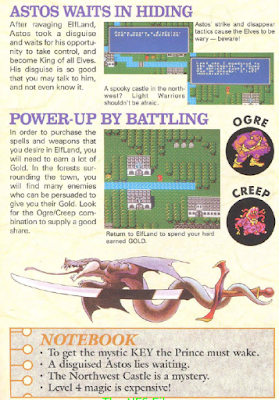 |
| The manual makes it clear that grinding is expected. |
Leveling up happens immediately after the battle in which you cross the threshold, and like Wizardry, you get boosts in a random selection of attributes. The frequency of leveling has thus far been satisfying enough.
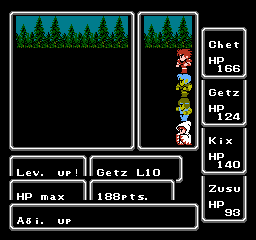 |
| My thief levels up at the end of combat. |
That leaves the game’s plot, which has been distressingly linear for this session, at least. What looks like a relatively open world map artificially channels the player through the use of terrain. At the beginning, the player can’t leave a small strip of land between the castle and the temple being occupied by Garland. Finishing the first mission is a simple matter of entering the temple and finding Garland in the first room. He attacks alone and dies quickly; the random monsters roaming throughout the temple are harder than him.
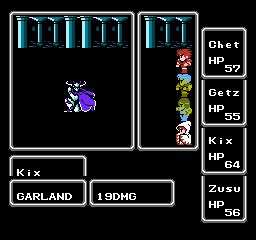 |
| Battling the first “boss” enemy. |
The princess is freed and returns to the castle, and one of the nice things about the game is that NPC dialogue in the castle and nearby town changes to reflect her rescue. The king and queen now offer thanks, and other NPCs who had lines about the princess have substitutes instead. Even in its later editions, Ultima didn’t often make such concessions to the changing game world, and it’s one of the several small signs that more care and craft went into Final Fantasy than the typical RPG of the 1980s.
In gratitude for her rescue, the princess gives the party a lute. The king has a bridge built from the land you’ve been able to explore to the main continent, extending the party’s range. He also tells the party to “make the ORBS shine again,” which is another clue as to the developing plot. As the party crosses the bridge, the title screen finally appears, suggesting that the game so far has been a prologue. A few text windows add here that the ORBS used to shine with light 2,000 years ago.
 |
| Everyone in the area has different dialogue once you’ve rescued the princess. |
The party next encounters a witch named Matoya living in a cave to the north. She demands the return of her crystal. If you talk to one of her magically animated brooms, you get a secret key combination that brings up a map of the world with the party’s location and the locations of places to visit clearly annotated.
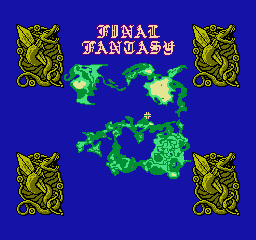 |
| The game world. You start north of the inner sea on the southern continent. |
Moving on, the city of Pravoka has been invaded by pirates. If the party wins a single battle against the pirates, the pirate captain (Bikke) capitulates and gives the party his ship. This opens up the game world a little. The problem is that the ship can only embark and disembark at docks, and the dock to which it is attached is on the continent’s inner sea. There are only a few places to land from here. A variety of sea monsters attack the ship, but frankly I wonder why we bother to stop and fight some of them. You can imagine that that the “sahags” are clambering aboard the ship and engaging us in melee combat, but why are we fighting sharks?
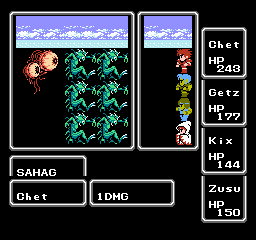 |
This game likes to include Dungeons and Dragons enemies but with skipped letters. I suppose “sahags” are sahuagins, but they could also be seahags.
|
West along the sea, the party comes to Elfland, another structure with a castle and town. The castle was sacked a few years ago by someone named Astos, who put their prince in a magical slumber. Only some herb from Matoya will awaken him. While searching for Matoya’s crystal, I come across a castle where the king says that Astos betrayed him. He asks me to get his crown from the Cave of Marsh.
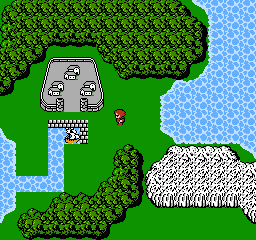 |
| We find our ship waiting in Pravoka’s port. |
The Cave is easily the hardest part of the game so far. A three-level dungeon, it is full of tough random encounters, including plenty of enemies that can poison the party, for which we need to keep a large stock of curing potions. I had to grind, try, grind, and try again for several hours before I was able to survive the journey to the third level, the boss combat against several wizards (who are guarding the crown), and the journey back.
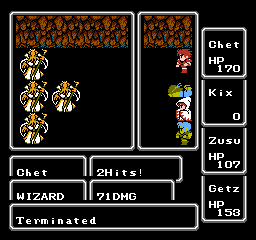 |
| A difficult combat that I had trouble winning with all my characters alive. |
Returning the crown to the mysterious king, we find that he has tricked us and that he’s Astos. His triumph is short-lived, and soon the party has left the castle, Matoya’s crystal in our hands, Astos’s body on the floor. Thus begins a lot of backtracking. We have to circle back through Elfland to the ship, take the ship to Pravoka, then walk to Matoya’s cave. Matoya takes the crystal and gratefully gives us the herb for the prince.
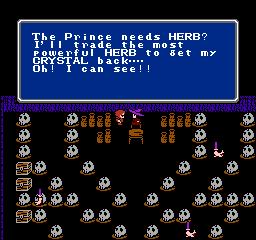 |
| The prince needs an herb. It has a different connotation if you say it that way. |
We thus reverse our travel and go all the way back to Elfland. The prince is awakened, and he gives the party the mystic key.
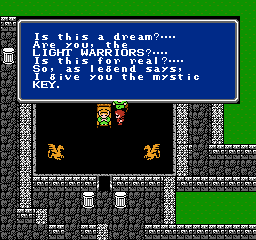 |
| I feel like we could have saved ourselves a lot of time by taking it from him while he was sleeping. |
I was wondering when I’d finally get this. Throughout the game so far–at both castles, the temple, and the Cave of Marsh–there have been multiple locked doors that require this mystic key. Now that I have it, I have to backtrack through just about every location I’ve visited so far. It’s mostly worth it, as some of the items I find are powerful weapons armor, but it’s still a lot of time.
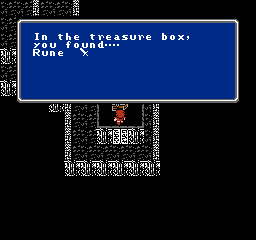 |
| The runesword is a decent weapon. |
All the way back at the original castle, the key opens a door to a treasure chest that contains TNT, which turns out to be prized by the king of the dwarves, who is building a channel between the inner sea and outer. Once we deliver the TNT to him, he finishes the channel and now the ship can sail just about anywhere, finally opening up the world. I suspect I’ll still continue to find plot linearity, but we’ll see.
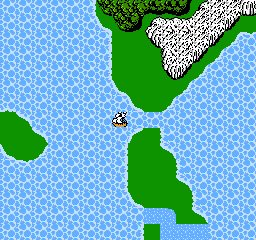 |
| Now we can get around. |
I’m used to console games making things easy for the player and not requiring the type of mapping and note-taking that a computer RPG often requires. This game is a little different; if you don’t take some notes, you’ll swiftly lose track of who wants what object and why. The manual tries to instill a note-taking ethos in the player by suggesting bullet points at the end of each city. That’s fine for me, in 2020, at the computer, but I don’t know how I would have felt about it in 1990 on the couch. To the extent that console RPGs have any appeal to me, it’s that I can play them somewhat mindlessly from a semi-recumbent (or, let’s face it, sometimes fully recumbent) position. If I reach for an end table, it’s going to be at most for a potato chip or bottle of soda.
I haven’t spoken much about the graphics. I like the monster graphics. As for the protagonists, they are what they are. As usual, they look like children. The manual is clearly written for children. There’s something childish about all RPGs, perhaps all video games, but I wish that Japanese RPGs didn’t have to emphasize it so much. You have to imagine that it limited their markets. Kids may not mind role-playing kids but probably also don’t mind role-playing adults. Adults, meanwhile, probably don’t want to role-play kids. I hear a lot from readers who had Nintendos in the 1980s when they were kids and still look upon the games fondly. I don’t think I’ve heard from a single person who was an adult in the 1980s and started on the Nintendo. This is not true, of course, about personal computers.
 |
| The manual not only walks you through the first part of the game step-by-step, but it also provides a summary of the walkthrough. |
But beyond the graphics, there’s an intriguing complexity to this one, and it helps me understand why the series became so popular. There’s still a lot to say about the influence of the game and the people who made it, so we’ll have a second entry after I’ve won The Legacy and Ultima VII.
Time so far: 7 hours
Original URL: http://crpgaddict.blogspot.com/2020/06/game-370-final-fantasy-1987.html


























